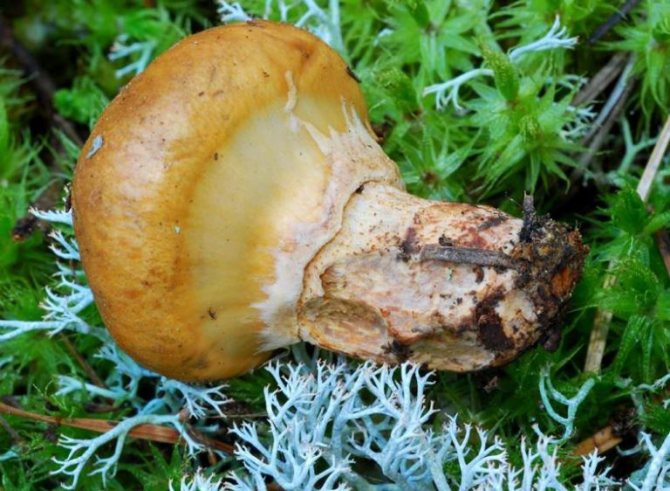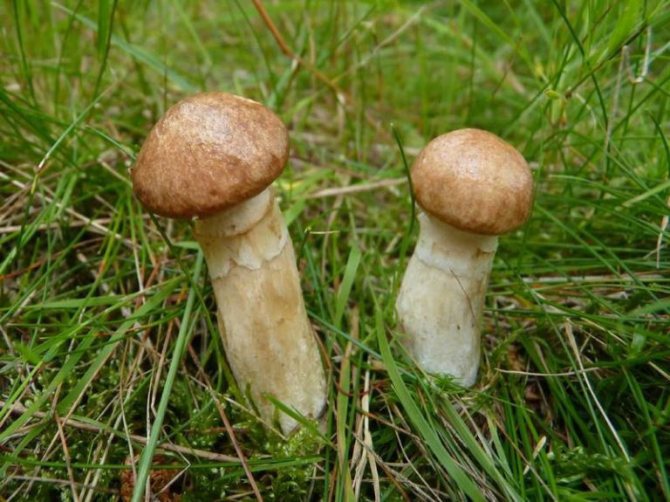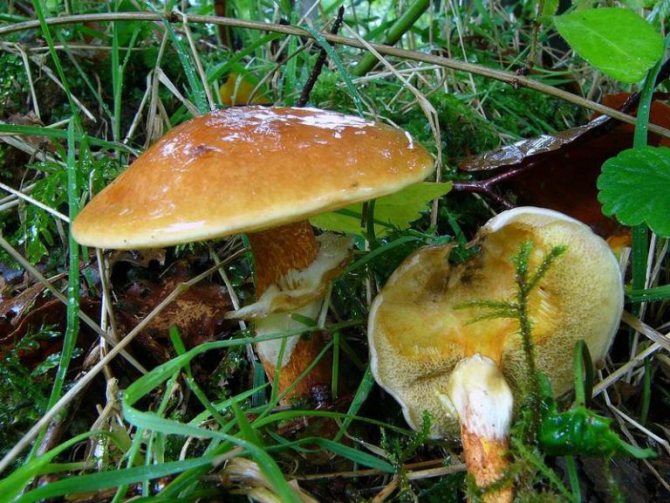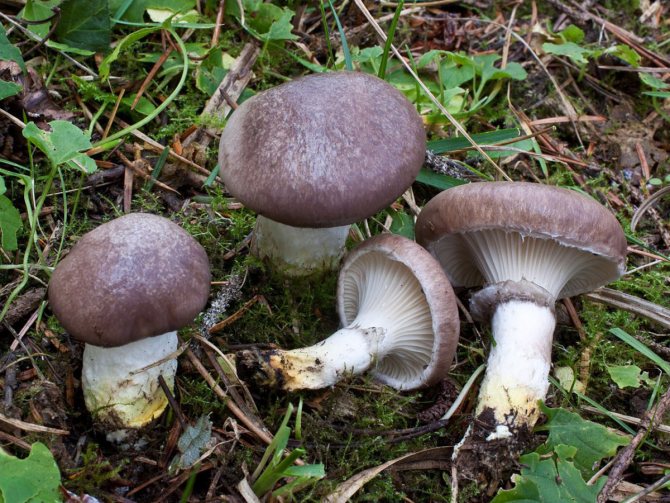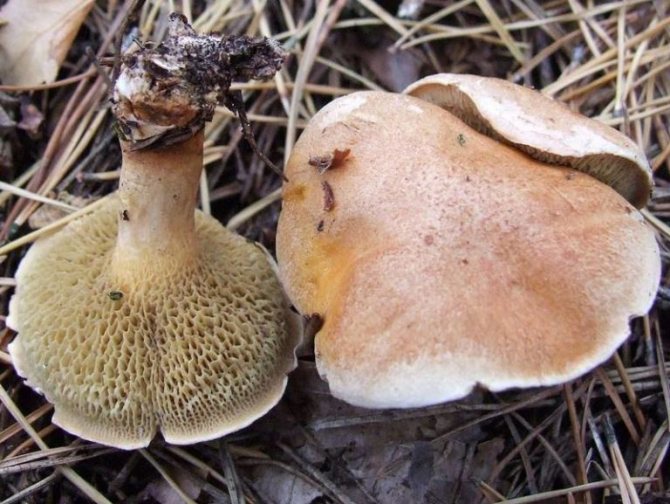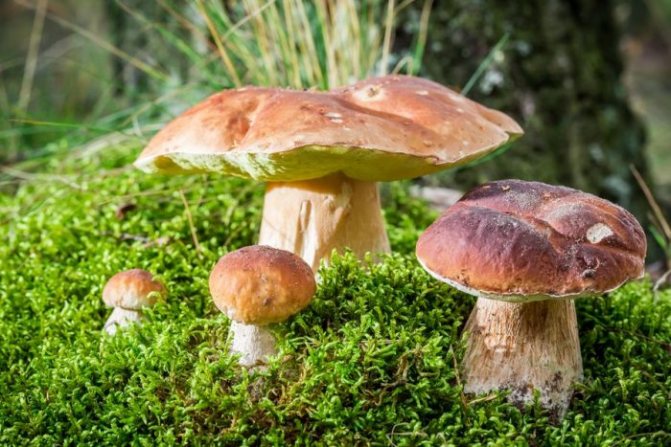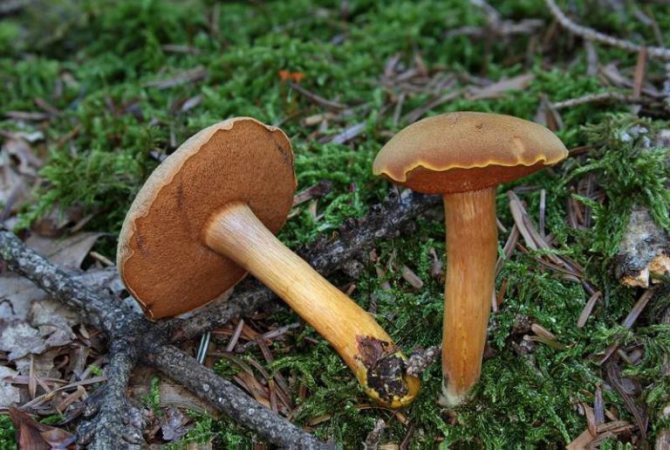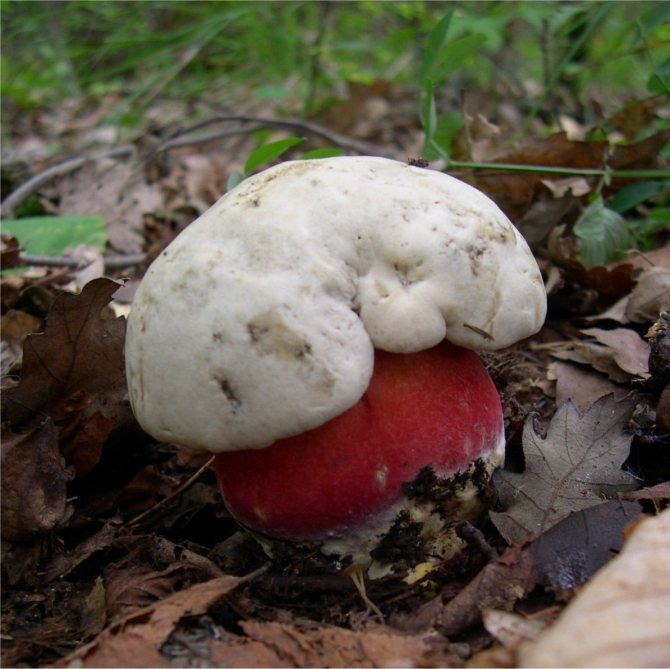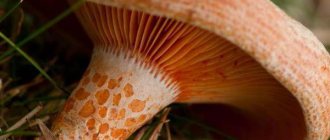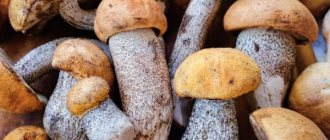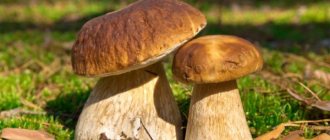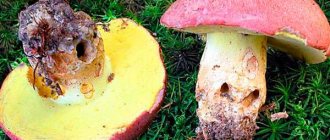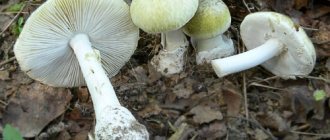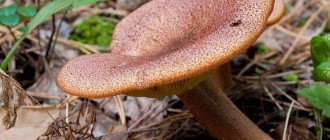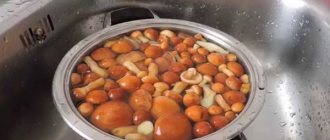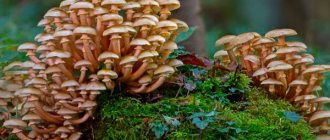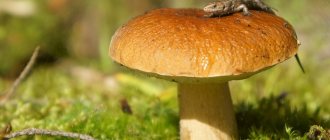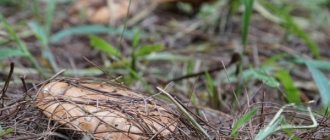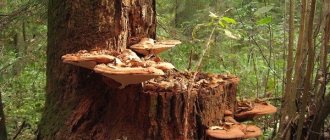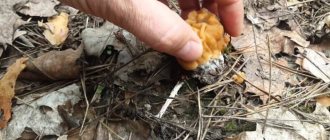Among the 50 varieties of boletus, there are 2 inedible species: yellow-brown and Siberian. They are not toxic, but completely tasteless. Outwardly, they are similar to edibles, their seamy side is tubular. The main difference is that at a cut or break, the pulp becomes bluish-purple.
Edible mushrooms are often confused with peppermint mushrooms. They are reddish brown, and the inside of the cap has a large cellular structure. These mushrooms are not poisonous, but they taste very bitter. Although some mushroom pickers do not disdain them and boil them for 15 minutes before cooking to remove the bitter aftertaste.
Even more often, spruce moss is disguised as a butter dish. This fungus has a grayish or purple slimy cap. Its seamy side is not tubular, but lamellar and gray. Knowing these nuances, it is not difficult to visually distinguish the mushroom. In general, the mushroom is quite edible, but in our country for some reason it is not eaten. But if you put it in the same container where other mushrooms are located, then it will paint them lilac. Therefore, it is best to fold it separately.
All twins grow in the same conditions as edible mushrooms, ripening at about the same time - in summer and autumn. And mushrooms prefer to settle in spruce, pine and mixed forests.
Description
The scientific name for boletus - Suillus comes from the Latin noun sus, meaning pig. Therefore, Suillus means "pork" and refers to the fatty cap, which is common to different types of boletus.
Boletus mushrooms are distinguished from other mushrooms by:
- slimy caps;
- radially or randomly located pores;
- the presence of a partial cover between the cap and the leg;
- glandular specks;
- habitat among coniferous vegetation.
Unfortunately, many types of boletus mushrooms have only a few of these characteristics.
As mentioned above, one of the most obvious characteristics of oil is a slimy cap. Of course, the surface may not be very sticky in dry weather, but signs of a mucous layer are visible because debris adheres to the cap. In dried specimens, the cap coating also remains quite shiny.
In addition to the slimy texture, the cap is not very characteristic of this fungus, reaching 5-12 cm in diameter. It is round and convex, but smoothes over time. It is mostly brown in color, although it ranges from dark brown to reddish brown to yellowish brown.
The surface of very small pores is whitish to light yellow in color. In some types of oil, the pores are located randomly, in others radially. With age, the pores darken and become yellow to greenish-yellow in color. The spores that form in the pores are brown in color. In young fungi, the pore surface is partially covered with a veil. This blanket is mostly white and rips open the pore surface when the fungus forms spores. On mature mushrooms, the remnants of a partial veil can be seen as a ring around the stem and small pieces of tissue remain along the edge of the cap.
Butter mushrooms are rather squat, medium-sized mushrooms with a solid cylindrical stem 3-8 cm long, 1 to 2.5 cm wide.Some species have a ring formed from the remnants of a partial veil (a membrane that protects the pores that form spores under the cap along as the fungus develops).It is initially white, then slowly takes on a purple hue, especially on the underside. Above the ring, the whitish leg fades to match the cap near the top.
This part of the peduncle is also adorned with numerous clusters of cells called glandular punctures. These glandular dots darken with age and stand out from the rest of the peduncle in adulthood. Glandular dots appear as a result of cell swelling and resemble tiny bumps.
How do they look
There are about 50 varieties of butterflies, which are united by the main feature - a shiny, slippery oily cap. Thanks to her, the mushroom got its name: butter or buttermilk. Also among their distinguishing features is a ring-skirt with a long leg.
The most popular are the following edible types of butter:
- Early or grainy oiler
- Late or common
- Larch oiler
However, experienced mushroom pickers also welcome other, less well-known, but tasty species of the boletus genus: white, marsh, yellow-brown, American or gray.
Types of butter
Cedar butter dish
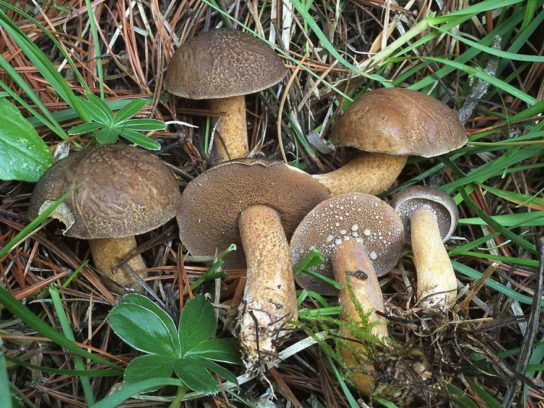
Mushroom cap up to 10 cm in circumference. In young specimens, it is hemispherical; with age, it becomes arched. Color from dark yellow to light or dark brown, dry or viscous. The stem is cylindrical or slightly swollen at the base. Sometimes the same shade as the cap, but more often paler, covered with brownish bulges.
The pulp is yellowish or yellow, does not change color upon contact with air. Tubules from dirty mustard to reddish color. The pores are small, rounded, mustard-colored. The smell is not distinctive. The taste is neutral. Spores 9–11.5 × 4–5 µm.
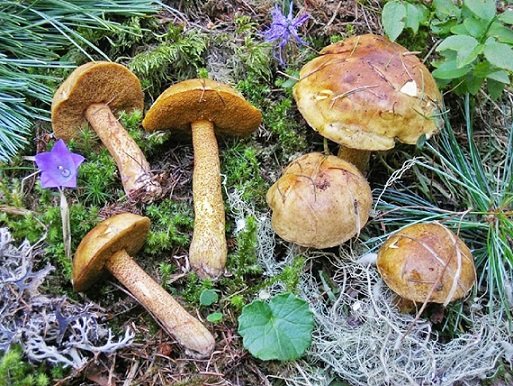

The cedar oiler lives in coniferous forests, under trees in parks and gardens, and forms mycorrhiza with pines.
Oiler gray
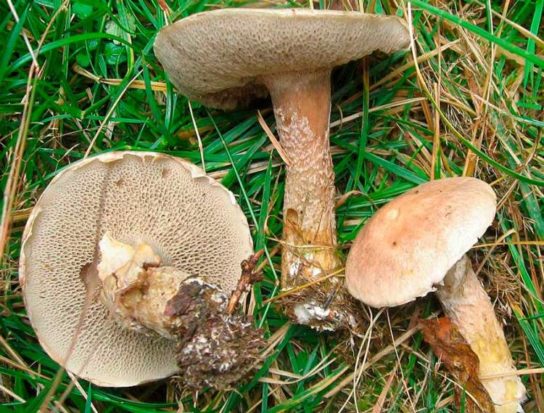

Outwardly, the mushroom is inconspicuous, but the taste is pleasant for food receptors, it has a characteristic mushroom smell when cooking or pickling.
A gray oiler is decorated with a cap in the form of a tuberous pillow, its diameter is 5-12 cm. The smooth film is damp and sticky on palpation, it is difficult to lag behind. A distinctive feature is brownish scales on its surface. When the veil breaks, it leaves flocculent particles that cover the tubular layer.
Pale gray to brownish, olive or purple peel. The white and loose flesh under the cap film in old mushrooms becomes off-white or brownish. Turns blue when exposed.
The bottom of the cap consists of wide tubes that run down the stem. The tubes are irregularly angular. The color is gray with a brownish, white or yellow tint.
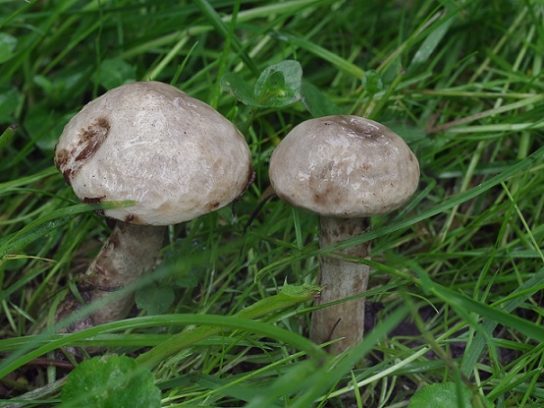

Gray boletus spores reproduce. They are formed in spore powder.
The high leg of a gray oiler resembles a straight or curved cylinder 1-4 cm thick and 5-10 cm long. The texture of the flesh is dense, the shade is pale yellow. The veil leaves a white rim on it, which disappears as the fungus ages. The gray oiler is collected in young larch or pine forests. The fungus grows in families or singly.
Butter dish yellowish (marsh)
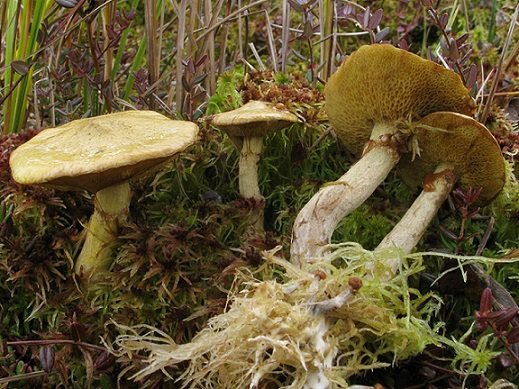

Swamp or yellowish butter dish is one of the most delicious representatives of the mushroom kingdom. He does not belong to the "noble" mushrooms, but experienced mushroom pickers know his value and brag when they find a mycelium.
The cap of the marsh oiler is small and not thick, in young mushrooms from 4 cm, in old ones up to 8 cm, covered with an oily film.
The developmental stages of the body affect the shape of the cap. Hemispherical in young specimens, it flattens over time and slightly stretches closer to the leg, a small tubercle appears at the top. The color of the cap is inconspicuous, yellowish. In some specimens, the yellowish color is diluted with beige, grayish or pale green tones.
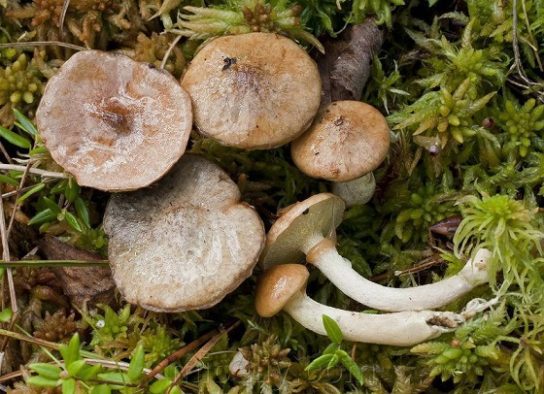

Quite small pores of the tubular layer of the cap are fragile, colored lemon, yellowish, or ocher.The yellowish flesh of the mushroom does not emit a pronounced odor and milky juice.
Strong cylindrical leg 0.3-0.5 cm thick, 6-7 cm long, slightly curved. After detaching the cap from the stem during growth, a jelly-like translucent ring of white or dirty yellow color appears on the stem. The leg is yellowish, yellow-brown below the ring. The shape of the spores is elliptical, the spore powder is coffee-yellow.
Butter dish white
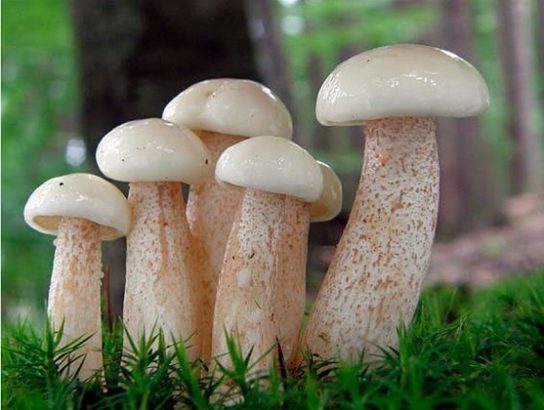

The mushroom is rare, so it is better to devote a mass collection to other representatives of the boletus family. Instances quickly deteriorate after collection and sometimes they simply do not have time to cook.
The cap of the mushroom is up to 8-10 cm in diameter. In young specimens, the cap is convex-spherical, the color is off-white, and turns yellow at the edges. In mature mushrooms, the bulge on the cap disappears as it expands. After overripe, the cap turns yellow and bends inward.
The smooth cap becomes covered with mucus after rain. When dry, it shines. Thin skin peels off effortlessly. The white or yellow cap has a soft, dense and juicy flesh. Blush as they age. The tubular layer is represented by tubes 4-7 mm deep. Young mushrooms have light yellow tubes. At a later age, they turn yellow-green. Overripe brown-olive. The color of angularly rounded small pores and tubes does not differ. The surface of the tubular layer gives off a red liquid.
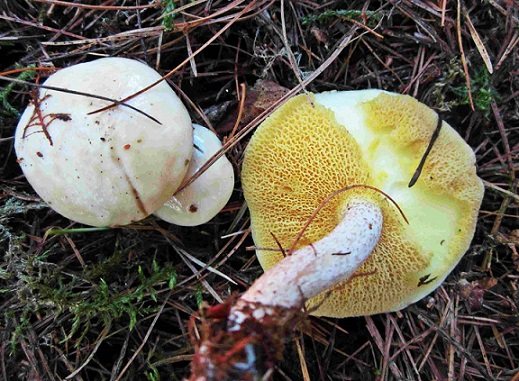

Solid stem, curved or cylindrical, without a ring, 5-9 cm high. When ripe, red-brown spots appear on the stem.
Late butter dish (real)
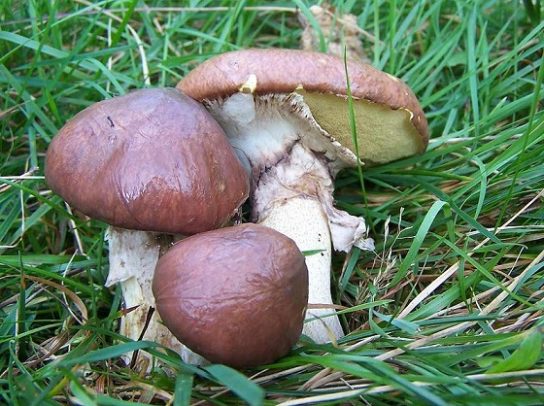

It is a popular mushroom, dried, ground into powder and used for mushroom broth. Wide convex cap 5–15 cm, opens as it ripens and becomes flatter. Sticky film from light brown to deep chocolate brown.
This is a mushroom, in which, instead of gills, the pores are creamy yellow, they look fleecy, as the fungus ages, the pores acquire a golden yellow color. Under the cap, a white veil covers the young pores, when the mushroom grows larger, the veil breaks and remains on the stem in the form of a ring. The leg is cylindrical, white, 4 to 8 cm high, 1 to 3 cm wide and rather smooth to the touch.
Larch butter dish
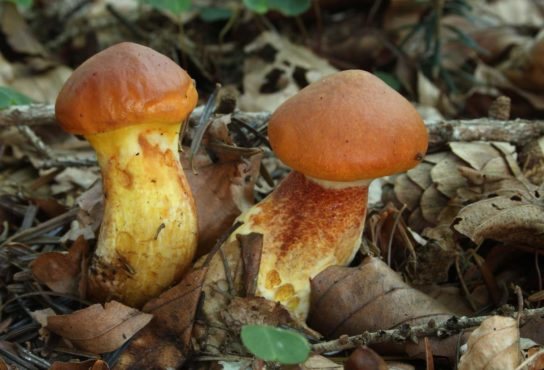

The fungal mycelium of the deciduous oiler and tree roots exchange nutrients for the mutual benefit of both organisms.
The hat is pale yellow, bright chrome yellow or bright rusty yellow, wet after rain and shines even in dry weather. Diameter 4 to 12 cm in adulthood and becomes almost flat, sometimes conical or with a noticeable raised central region. The caps of large specimens are somewhat wavy at the edge.
Lemon yellow angular pores acquire a cinnamon hue as the fruiting body matures. When bruised, the pores turn rusty brown. The tubes are pale yellow and do not change color when cut. The stem is 1.2 to 2 cm in diameter and 5 to 7 cm long. A thin white veil covers the tubes of immature fruiting bodies, forming a transition ring of the stem. When the ring falls off, a pale area remains on the stem.
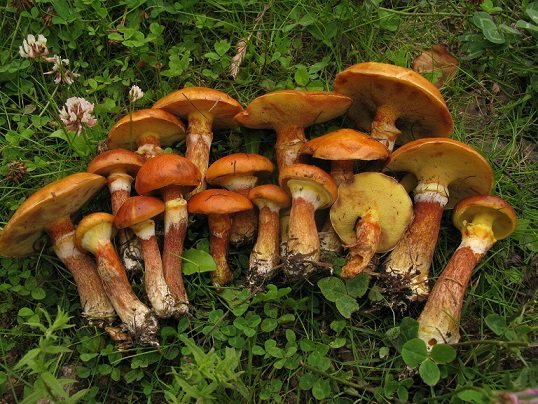

Most of the stem is covered with brown dotted scales, but above the annular zone, the stem is paler and almost scaleless.
Granular butter dish
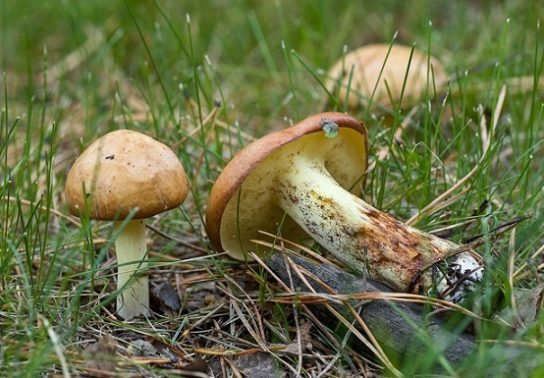

Mycorrhizal fungus with pines, grows alone or in groups; widespread.
The hat is 5-15 cm, arched, becomes a wide arc over time, the texture is smooth, sticky or slimy to the touch. Changes color from dark yellow, yellow or pale brown to dark brown or brown-orange. With age, the color fades, becomes patchwork with different shades. The veil disappears. The pore surface is whitish at first, then turns yellow, often with droplets of a cloudy liquid in young mushrooms. The tubules are about 1 cm deep. The pores are about 1 mm in mature specimens.
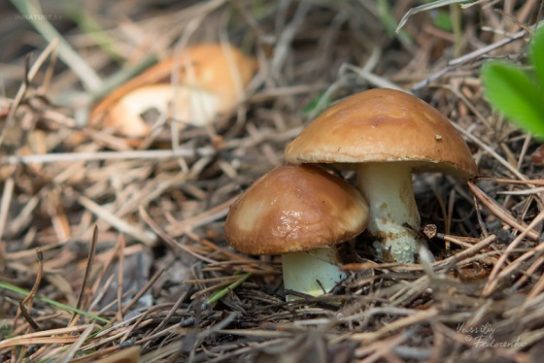

Stem without ring, white, with a bright yellow tinge near the apex or the entire stem, 4-8 cm long, 1-2 cm thick, equal to or with a tapered base. The upper half has tiny, brown or brownish glandular dots. The flesh is white at first, pale yellow in adult mushrooms, does not stain when exposed. Odor and taste are neutral.
Cooking recipes
Freshly picked mushrooms must be cooked immediately, as they quickly deteriorate. The first thing to do is to wash and clean, remove the skin from the cap of the mushroom. Boil clean oil for at least 20 minutes. Boiled mushrooms can be fried, like other mushrooms, until tender - about 15 minutes.
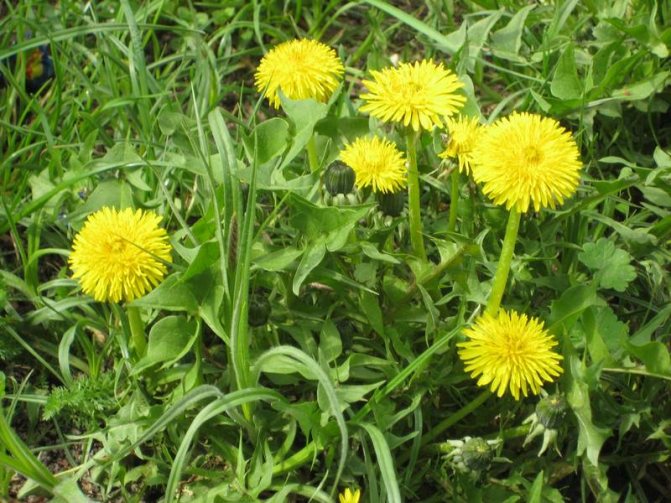

You can prepare butter and marinate them for the winter. This will require:
- 1 liter of water.
- 2 tbsp. l. salt.
- 3 tbsp. l. Sahara.
- Allspice peas (8-10 peas are enough).
- 1 clove.
- 1 clove of garlic
- Dry dill and bay leaf.
- 2 kg oil
Rinse in multiple waters and peel the mushrooms. Cook in lightly salted water for 10 minutes. Add 3 drops of vinegar to the water. Pour out the first water. Cook again for 15 minutes with the addition of salt, sugar and spices. Then put the butter tightly in a jar and pour over the marinade. Add 1 tablespoon of vinegar 9%. Pickle mushrooms only in sterilized containersand store in a cool place.
Butter mushrooms are tasty and healthy mushrooms. Their main qualities are unique composition and excellent taste. Dishes made from them are a worthy snack that will be appreciated even by true gourmets.
Mushrooms that look like boletus (false)
Mushrooms similar to boletus are conditionally edible. They taste bitter and upset the gastrointestinal tract, but do not lead to fatal consequences after consumption. False boletus rarely comes across mushroom pickers and have insignificant external differences from real edible mushrooms. Doubles:
Pepper oiler
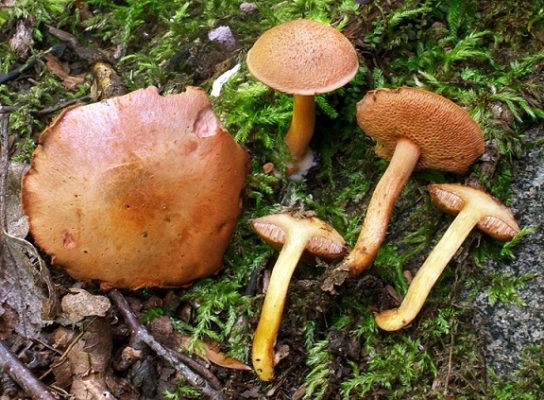

Siberian butterdish
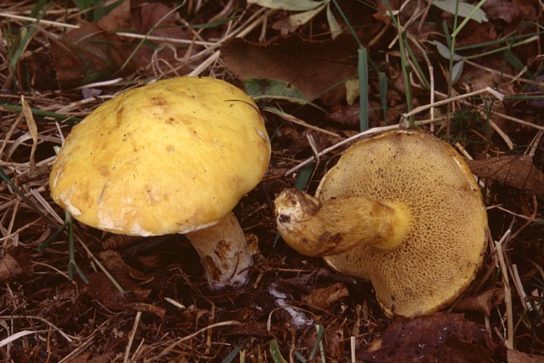

Goat
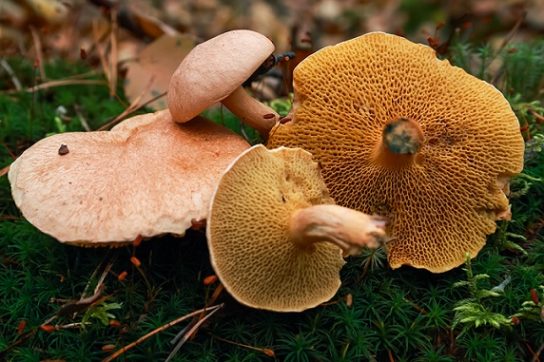

When you look at mushrooms, it seems that it is impossible to distinguish between false and edible boletus, but if you look closely, this is not so. Conditionally edible mushrooms have a purple-tinged cap and a gray film. A real oiler has a white film. The place of damage to the inedible mushroom turns yellow.
The twins are thoroughly cleaned and treated with high temperatures at least twice, only after that they are eaten. However, the Siberian butterdish retains its bitterness regardless of the number of cooking cycles.
Poisoning reasons
Even when collecting edible oil, you can get poisoning, although this does not happen often.
The main causes of poisoning:
- The oil is collected in the wrong place (along roads or near hazardous enterprises).
- The cooking technology and sanitary standards have been violated.
When poisoning occurs nausea and abdominal pain... The victim must be given an adsorbent, given water to drink and provide rest, and in severe cases, urgently call emergency help.
Contraindications
No matter how useful mushrooms are, there are always contraindications. Oilers contain fiber impregnated with chitin, which interferes with digestion in case of disturbances in the digestive tract.
Contraindications:
- individual intolerance;
- pregnancy or breastfeeding;
- acute gastrointestinal diseases;
- children under 7 years old.
All mushrooms accumulate harmful chemicals if they grow near an industrial plant or a rural area treated with herbicides. The radioactive substance cesium is also found in the body of mushrooms. The collected mushrooms are soaked several times before thermal cooking, boiled at least twice with a change of water.
Beneficial features
Butterlets are valued for a lot: both for their taste and for the ease of collection, since they usually grow in a heap. They consist of 90% water, but the rest of the composition is proteins, carbohydrates, minerals.
The oils also contain such useful substances:
- calcium and phosphorus salts;
- trace elements such as copper, iodine, zinc, manganese;
- a large amount of vitamin B and PP;
- amino acids close to animal proteins;
- polysaccharides.
- lecithin;
- natural antibiotics and immunostimulants.
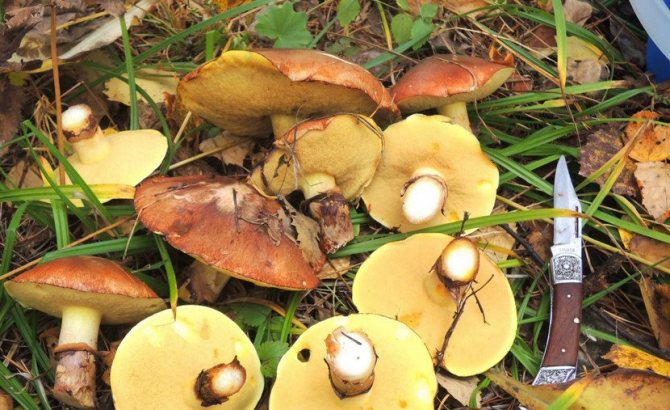

The largest amount of nutrients and useful elements is found in young mushrooms. Butterlets are quite low in calories (19.3 kcal per 100 g), so they can be eaten by those who are trying to lose weight. The digestive system assimilates oil proteins quite easily.
Did you know? The composition of oil contains a specific substance phenylethylamine, which makes a person feel in love. They also contain allergens.
These mushrooms have a beneficial effect on certain processes in the body and help fight certain diseases.
- Medical benefits of oil:
- thanks to antibiotic substances, they suppress pathogenic microbes;
- stimulate immunity;
- the resinous substances covering the cap help fight gout and also remove uric acid;
- positively affect the thyroid gland, normalize the hormonal background;
- increase the level of hemoglobin;
- have a positive effect on the functioning of the central nervous system;
- properly prepared tincture of mushrooms gives an analgesic effect;
- active ingredients can help restore liver cells;
- contribute to the prevention of cardiovascular diseases, disorders in the work of the musculoskeletal system, cancerous tumors;
- to some extent increase potency.
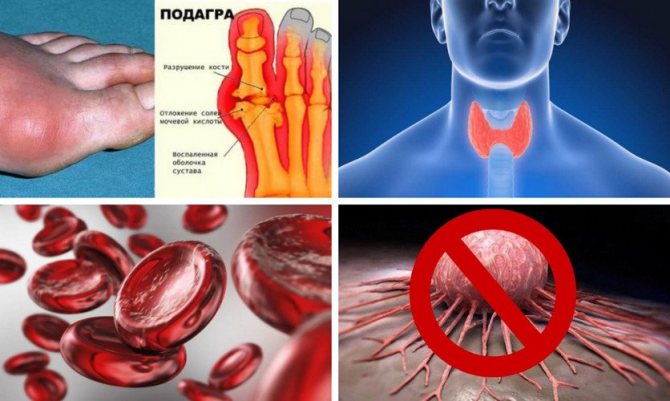

But, in spite of the huge number of useful properties, the use of oil may have some disadvantages.Mushrooms contain chitin, which is beneficial for people with a healthy digestive system. However, for people with gastrointestinal disorders, this is a rather heavy food, and it should be taken in limited quantities. With exacerbations of ulcers, gastritis, liver disease or kidney failure, it is better not to eat mushrooms. Also, mushrooms are contraindicated for small children.
Important! The oil also does not have a good preservation, therefore, after collecting them, they must be immediately processed. When cooking, they are finely chopped. Heat treatment, cooking is required, especially for the legs.
In addition, the oily film of oil tends to absorb radiation and harmful substances from the environment. In young mushrooms, it is not so dangerous, but in mature mushrooms, it must be removed. Thus, boletus has more beneficial properties than harmful ones. But for them to bring maximum benefit, you need to adhere to simple rules.
Video: Useful properties of butter
Choose edible
Even after looking at one photo of mushrooms from the boletus genus, you will no longer be mistaken "on the exam" in the forest. However, you should be careful, as inedible or too tasteless mushrooms are often found under the oily caps.
For example, a false oil can badly affect health, which can be recognized by the lamellar bottom of the cap, the yellowing cut and the gray tint.
Also, do not put mushrooms in the basket that turn blue after contact with a knife and have darkish caps.
Butters can be boiled and steamed, fried and salted, dried and baked. Some recommend not to salt them, others - to use them mainly with potatoes, and still others - to soak them beforehand.
How to cook them is everyone's business, and it is better to solve it by having fresh and aromatic butter on the table.
Benefit and harm
The pulp of butter contains a large amount of vitamins, minerals and nutrients - proteins, carbohydrates. They contain a lot of protein, which is well absorbed by the human body. Of course, after cooking the boletus loses some of its beneficial properties, but it still remains an excellent source of vitamins and minerals. Many believe that they are even more beneficial than porcini mushrooms.
This mushroom is also used in medicine, as the skin of their cap contains antibiotics. They treat headaches, cardiovascular system, adjust the metabolic rate.
But it is worth remembering that boletus, like sponges, collect all slags and toxic substances from the soil or air, so they should not be collected near highways or industrial enterprises, otherwise you can easily get poisoned and go to the hospital.
Butterlets are one of the first mushrooms to fill up mushroom pickers' baskets in summer. They are fruitful and grow almost everywhere, which makes harvesting quick, interesting and enjoyable. It's so great to come back from the forest not empty-handed.
Growing periods
This variety loves moisture, which means it grows after rains, especially during the period when sunny weather has come after a cold snap. Ripening of mushrooms begins from June until frost. But if the summer turned out to be hot with a little rain - boletus in the forest will be rare. This variety loves a temperate, mild climate and a sufficient amount of moisture.
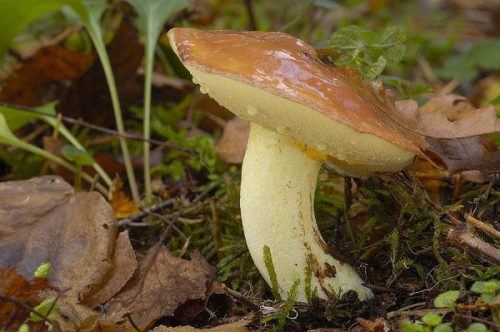

When choosing butter, it is worth remembering that small specimens, the diameter of the cap of which does not exceed four centimeters, are much tastier than overgrown butter. They have a delicate texture and sweetish taste with a pronounced mushroom aroma. It is better to leave older specimens in place, in this they will have time to throw out the pores, after which the number of fungi in their places of growth will significantly increase.
Interesting Facts
- Butters are mushrooms that synthesize the largest amount of vitamin D.
- Butterlets grow towards the light. One could notice that this group of mushrooms is never straight - it is always tilted to the side. This is precisely because of the "pull of the sun".
- Butterlets were specially sown on the territory of the Chernobyl nuclear power plant in order to reduce the level of radiation. In tropical conditions, the boletus feed on ants and midges, dissolving them in their mucus.
- Butterlets are banned in many countries and are considered poisonous mushrooms in England and Germany.
Growing at home
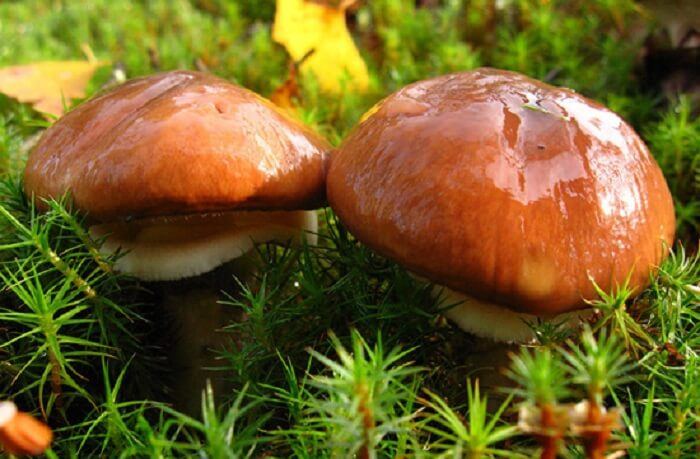

It is not customary to grow boletus at home. They cannot be planted in pots or jars. In order to get a good harvest of these mushrooms, you will need land planted with conifers. If you do everything correctly, then after a few weeks the mycelium will begin to bear the first fruits.
First, you need to choose the right trees - they should be 10-15 years old. You don't need to look for a whole forest - just a few pines are enough. This choice is due to the fact that young trees take less micronutrients, which are needed for good fungal growth.
Before planting, you need to remove the top layer of earth up to 20 cm. Then you need to put withered leaves and soil fertilized with humus. Pieces, and ideally whole mushrooms, sit in such a mixture. It is rarely necessary to water the boletus, it is best to ensure that they have enough sun. If there is such a problem as a lack of solar heat, then you need to cut off the branches of the trees.

